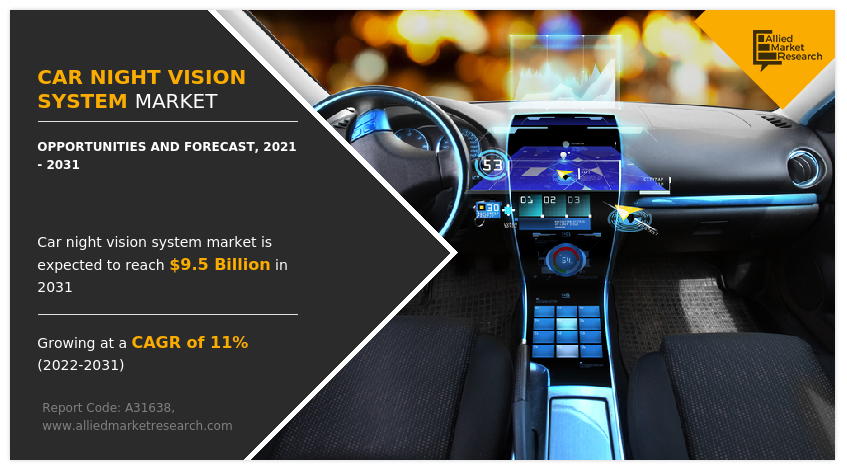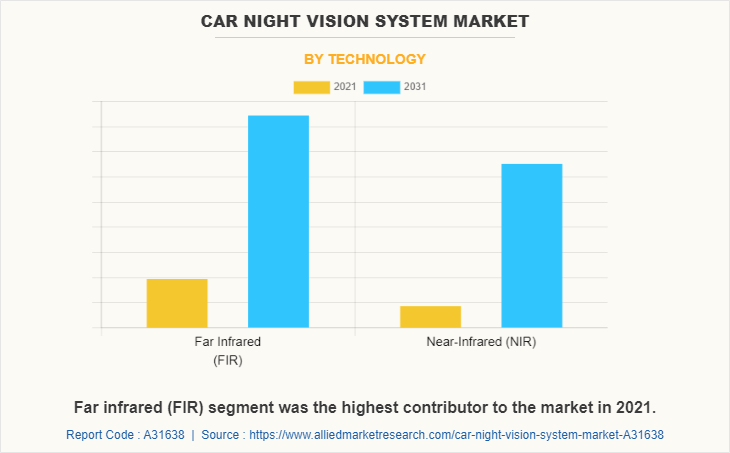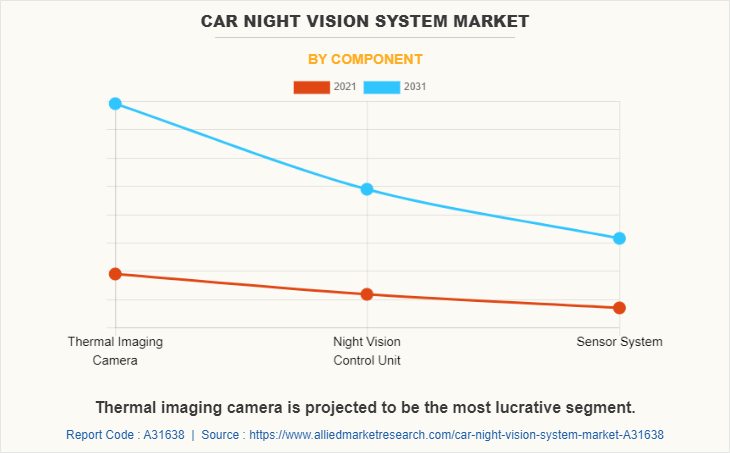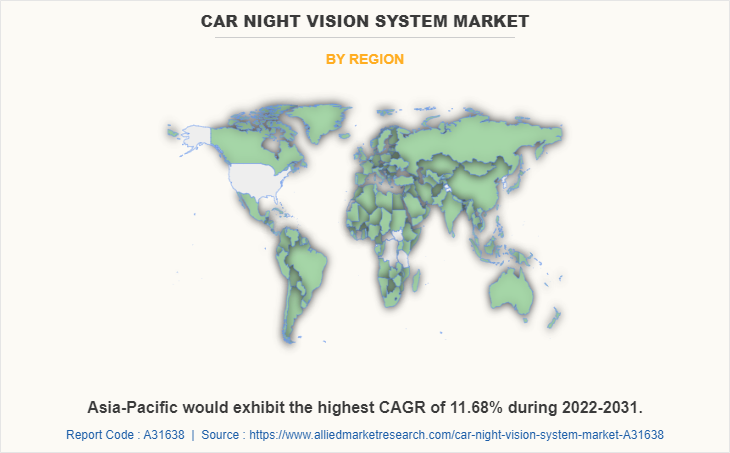Car Night Vision System Market Research, 2031
The global car night vision system market was valued at $3.4 billion in 2021, and is projected to reach $9.5 billion by 2031, growing at a CAGR of 11% from 2022 to 2031.
The reckless accidents that take place on roads during night times mainly owe to the poor visibility and make the car drivers envisage their way ahead rather than driving ahead. But this is not just the case of drunken drivers but also sensible drivers who find very bad visibility during the teensy hours of morning or the odd evenings. Thus comes the use of night vision systems which uses infrared sensors or headlights to provide a clear view of the road ahead. Humans are visible only to the rays falling under the visible region of electromagnetic spectrum and are invisible to both the infrared as well as the ultraviolet region of the electromagnetic spectrum. But night vision technology makes it possible for the humans to view the rays subsiding in the infrared region of the electromagnetic spectrum, that means usually the night vision systems used in automobiles capture the infra-red image of distant obstacles on road as every object emits infrared rays (heat rays) even during night. This image is viewed in a screen and the driver can thus apply the brakes as required.

The car night vision system market is segmented into Technology and Component.

By technology, the car night vision system industry is divided into far infrared (FIR) and near infrared (NIR). The far infrared (FIR) segment was the highest revenue contributor to the market.

Depending on component, it is categorized into thermal imaging camera, night vision control unit and sensor system. The thermal imaging camera segment was the highest revenue contributor to the market.

Region wise, car night vision system industry is analyzed across North America, Europe, Asia-Pacific, and LAMEA.
The infrared and thermal sensors are typically mounted in the vehicle’s grille and display images in the screen in the center console or dashboard. Newer technology can project the images in a heads-up display in the windshield, showing the exact location of traffic ahead. Both of these types of systems are typically controlled by the on-board computer mounted in the center console. If conditions make it difficult to see, having night vision can be a huge asset that affords many benefits. Car night vision uses thermo-graphic sensors to detect IR waves or heat back at the vehicle in order to determine the distance of objects ahead. If the road is poorly lit, the night vision will indicate the user what is in front of the vehicle, alerting the user to any obstacles sooner.
The night vision not only picks up other cars on the road, but pedestrians and other creatures, serving the user to avoid an accident. The global car night vision system market is segmented into technology, component and region. By technology, the market is divided into far infrared (FIR) and near infrared (NIR). According to the recent car night vision system market trends, demand for automotive night vision and on lanmodo night vision is experiencing significant growth in the automotive sector. Depending on component, it is categorized into thermal imaging camera, night vision control unit and sensor system. Region wise, it is analyzed across North America, Europe, Asia-Pacific, and LAMEA.
The significant factors impacting the growth of the global car night vision system market size include growing awareness among mass in road safety issues and growing penetration of luxury cars in developing countries. In addition, the market is affected by high prices associated with the night vision system products. Moreover, advancements in 3D technology regarding car night vision system influences the car night vision system market growth. However, each of these factors is anticipated to have a definite impact on the growth of the global car night vision system market share during the forecast period.
The key players profiled in the report include Audi AG, Denso Corporation, Delphi Technologies (BorgWarner Inc.), Robert Bosch GmbH, Bendix Commercial Vehicle System, Continental AG, FLIR Systems, Inc. (Teledyne FLIR LLC), OMRON Corporation, AutoLiv and Magna International Inc. These key players have adopted strategies such as product portfolio expansion, mergers & acquisitions, agreements, geographical expansion, and collaborations to enhance their market penetration.
Key Benefits For Stakeholders
- This report provides a quantitative analysis of the market segments, current trends, estimations, and dynamics of the car night vision system market analysis from 2021 to 2031 to identify the prevailing car night vision system market opportunity.
- The market research is offered along with information related to key drivers, restraints, and opportunities.
- Porter's five forces analysis highlights the potency of buyers and suppliers to enable stakeholders make profit-oriented business decisions and strengthen their supplier-buyer network.
- In-depth analysis of the car night vision system market outlook assists to determine the prevailing market opportunities.
- Major countries in each region are mapped according to their revenue contribution to the global market.
- Market player positioning facilitates benchmarking and provides a clear understanding of the present position of the market players.
- The report includes the analysis of the regional as well as global car night vision system market trends, key players, market segments, application areas, car night vision system market forecast and market growth strategies.
Car Night Vision System Market Report Highlights
| Aspects | Details |
| Market Size By 2031 | USD 9.5 billion |
| Growth Rate | CAGR of 11% |
| Forecast period | 2021 - 2031 |
| Report Pages | 166 |
| By Technology |
|
| By Component |
|
| By Region |
|
| Key Market Players | Delphi Technologies, Magna International, Inc., Denso Corporation, FLIR Systems, Inc., Robert Bosch GmbH, Bendix Commercial Vehicle Systems, OMRON Corporation, AUDI AG, Auto Liv, Continental AG |
Analyst Review
The car night vision system market holds high growth potential. The current business scenario experiences increase in usage of car night vision systems in automotive and transportation industries due to the awareness regarding accidents on road among the people worldwide.
Surge in awareness among mass in road safety issues and rise in penetration of luxury cars in the developing regions are the factors that drive the growth of the market. However, high investment issues regarding manufacturing and maintenance of the products related to car night vision system hampers the market growth. Conversely, advancements in 3D car night vision system is expected to create lucrative market opportunity.
The car night vision system market exhibits high growth potential in automotive and transportation sectors. The current business scenario has witnessed an increase in demand for advanced technologies, particularly in the developing nations such as China and India, owing to surge in population and rise in social awareness among the mass. Companies in this industry have adopted various innovative techniques, such as mergers and acquisitions to strengthen their business position in the competitive matrix.
The market growth is supplemented by proactive industrialization efforts and surge in manufacturing output, owing to technological advancements. These factors have allowed emerging economies to evolve as the potential markets during the forecast period both from the demand as well as the supply side. Moreover, public & private organizations have substantially invested in R&D activities and fabrication techniques to develop cost-effective car night vision systems.
The major types of Car Night Vision System are far infrared (FIR) and near infrared (NIR).
Asia-Pacific is considered to be the largest regional market for Car Night Vision System
The estimated industry size of Car Night Vision System is expected to be $3,368.7 million in 2021.
The major players in the Car Night Vision System industry are Audi AG, Denso Corporation, Delphi Technologies (BorgWarner Inc.), Robert Bosch GmbH, Bendix Commercial Vehicle System and others.
The Car Night Vision System Market is expected to grow at a CAGR of 10.98% from 2022 to 2031.
Loading Table Of Content...


